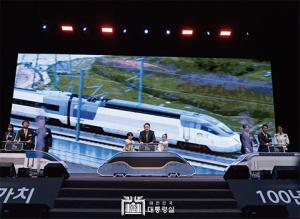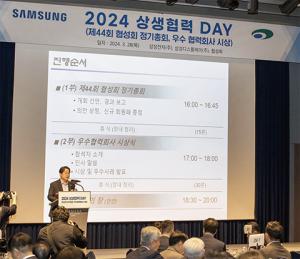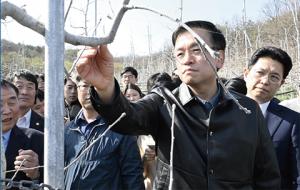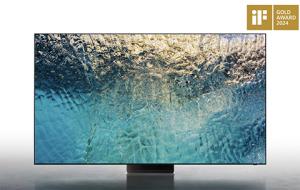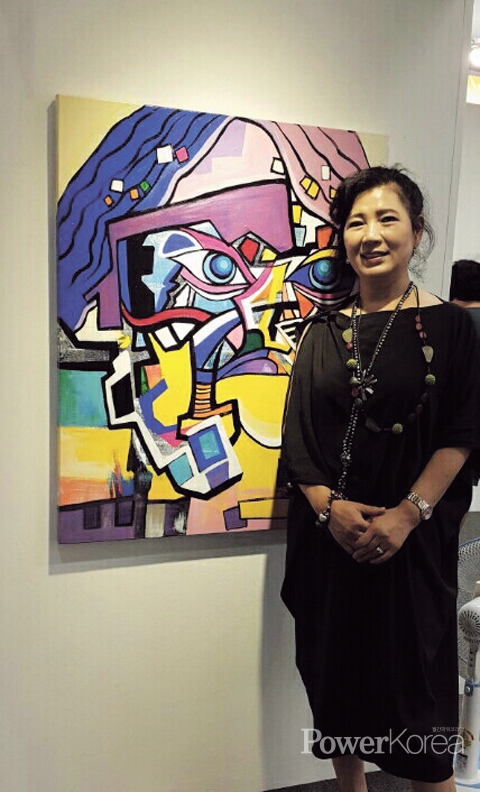 |
||
| ¡ã Artist Ki Ok-ran | ||
“Trans-human is future of humanity”
The term ‘trans-human’ was suggested in a book of a French economic and social writer Jacques Attali. He suggests trans-human as a hybrid of the nomadic and the settled thus a newly civilized man. He argues that this new civilized man can revive the value of humanity in this me-me-me society today and can be the leader of our future society.
In Korea, Jacques Attali’s trans-human is readopted in a series work titled ‘Trans-Human’ by a Korean artist Ki Ok-ran who sticks various objects into a single work as a tool to deliver her message to the people: ‘Recovery of humanity, Towards a new society’.
Ki sees conceptions of 4D, DNA, digital, design, divinity, 3F, feeling, female and fiction as supportive sources of her inspiration alongside the ideas of trans-human. For instance, you can image a future man by carefully observing her works made of computer parts such as motherboard, CPU cooler, memory and graphic cards, cords and batteries, or of bolts and nuts, natural fiber and denims, and Korean paper and metal plates in the form of a man.
“A rainbow is a harmony of seven colors. Races of different colors live together on earth. Streams from the unknown origins flow down into a big flow. Heterogeneous objects meet to create mysterious power. But all of these resonate in transcendental relations and beautiful harmony” says Ki.
She continues “Recovery of humanity is the most important topic of man because that makes us review on our identity and independence in this material world. Materials take up our space, form a network and speak to us. They are the tools and expansion of our thought and we reflect ourselves into them. But what we see is not an object but the very self of our own. In this regard, 3 dimensional objects for me are the images of our history on which I deliver my pursuit of reconciliation between men, between cities and nature, between men and nature, and between men and objects.”
Trans-human is closely related to Ki’s view on coexistence between male and female, desire and transcendence, nomad and settlement which are making their way forward like a song of variation; and the formative beauty of Ki’s works is but a result of these insights and then again resulted in her variation series themed on relations and communications, for space, and for spatial thought.
She also adopted ‘rhizome’ introduced by French philosophers Deleuze and Guattari. Rhizome is a philosophical conception used as a model for immanent and inclusive relations as opposed to dichotomous, ranking and transcendental relations.
Ki’s works are well received both in Korea and overseas. She has had more than 40 exhibitions including the solos in Paris, Venice, New York and Berlin where cutting edge art trends entertain the citizens. Last year, she joined the 2017 Venice Biennale project exhibition for a month and was invited to an art fair at The Louvre and an invitational exhibition at The Musée d'Orsay.
And she is yet to have another solo exhibition, alongside the Indépendant Exhibition, in Paris in February next year followed by an invitational exhibition in New York in the autumn.
If you can’t wait until early next year to see her works, make a journey straight to Mercedes Benz Exhibition Hall in Gwangju Metropolitan City where you can appreciate 50 of her works right now; or you can pay a visit to the KEPCO building in Naju City to see some of her works including ‘Variation for Trans-human and Underprivileged’, and ‘Beauty of Mingling’ which turned computer parts into city landscape to express communications and reconciliations through the mythic imagination of the ash tree called 'Yggdrasil' and 'doors'.
“I want to keep working on trans-human and neo-nomad while trying to make something new of commercial products relating to ornaments, cups, plates, umbrellas, scarves, handkerchiefs, handbags, high hills, snickers, T-shirts, cosmetics, stationery, tiles, wallpapers and electronic goods. I also want to create some collaborative works and if possible I’d like to build a communicative museum one day in the future.”
We should respect nature, save energy, accumulate without damaging others, leave a trace without a hurt, be strict on mood swing, find pleasure in other’s pleasure and be ready to leave anytime like nomads (...)
Trans-human leads a life as light as a feather, doesn’t bother the possessions, accumulate nothing but ideas, experience, knowledge to avoid being a slave to dictatorship and money, and be comfortable with instability (...)
Trans-human knows how to share, listen and be silent and doesn’t ignore people in anguish. Trans-human waits a traveler whom he/she doesn’t know of but welcomes with all heart. – extracts from L'homme nomade by Jacques Attali -
Portrait einer durch geisteswissenschaftlicher Selbstreflexion und der Harmonie der Sinnesgestaltung gemachten neuen Generation: „Transhuman“
Aktive Beteiligung in Ausstellungen verschiedenster Länder, wie in Paris, New York, Venidig und Berlin
Ein Werk basierend auf dem Thema „Transhuman“ - Die neue Generation des 21. Jahrhunderts
Ok-Ran Ki beschreibt die Eigenschaften der neuen Gesellschaft des 21. Jahrhunderts als 4D, heißt die in der Generation der Biotechnologie existierende führende ‚DNA‘, das ‚Digital‘ der gegenseitigen Kommunikationsgeneration, das die Konsumgeneration wiederspiegelnde ‚Design‘ inform von Signalen, Bildern, Videos, Architektur, etc., die für die menschliche Logik verantwortliche Divinity (Göttlichkeit), sowie den 3F, Feeling (Gefühle), Female (Weiblich) - das die Notwendigkeit der Wiederherstellung der Weiblichkeit mitteilt, in einer auf Männer fokusierte Gesellschaft, die seit der Bronzezeit durch Werkzeuge der Macht und Domination gemachte Waffe bildete Religion, Nationen und Städte - und Fiction (Fiktion). Diese Eigenschaften bilden den großen Stamm ihres Werkes, während sie basierend auf philosophischem Denken arbeitet.
Die führende Schriftstellerin mit 30 jähriger Erfahrung präsentiert seit 2010 Werke unter dem Thema „Transhuman“, bei denen sie vielfältige Objektkünste verbindet und damit den globalen Künstlerkreis in einen erfrischenden Schockzustand versetzte. In ihren Werken werden verschiedene Linien und Flächen vermischt, die dreidimensionale Elemente aufzeigen und einen Spielraum hinterlassen, der die Einbildungskraft anregt. Sie verwendet dabei Materialen die keineswegs in einem Bild zusammenpassen, wie verschiedene Teile eines Computers, Tastaturen oder Mainboards (Motherboards), CPU Kühler, Speicher, sowie verschiedene Konstruktionen aus ausgeschnittenen Eisenplatten, und verkörpert dadurch die menschliche Gestalt. Ausserdem bildet sie Objektkunstcollagen aus Kupferdraht und Naturfaser, Jeansstoff, Reispapier, etc., um in der Aussenwelt eine neue Art der Kommunikation zu suchen.
Bildung einer schöpferischen Welt aus geisteswissenschaftlicher Selbstreflexion und Harmonie der Sinnesgestaltung
Neben der „Transhuman“ Reihe, bildete Ki eine noch tiefgründigere eigene Welt durch die Vertiefung einer ähnlichen Kunstwelt. Dazu gehören „Variationen zur Beziehung und Kommunikation“, „Raumvariationen“, „Räumliches Denken“, etc.. Einer der Gründe, warum diese Art der Gestaltung ihrer Werke möglich war ist, dass sie in ihrer eigenen Welt durch Rhizom die Ästhetik von repräsentativen Beziehungsbündnissen aktiv ansammelt. Sie verwendet dabei das von den französischen Philosophen Deleuze und Guattari präsentierte philosophsche Konzept des Rhizom, ein in dichotomer Konfrontation entwickelter und angeordneter transzendenter Aufbau und Aufstellung, welches ein sowohl immanentes also auch nicht-exklusives Modell ist. In ihren Werken, die nach der Versöhnung und Vereinigung von Menschheit und Natur suchen, schwingt auch der starke künstlerische Glaube, der sich in der Hoffnung in die sich nähernde Zukunft zeigt.
Aktive Beteiligung in Ausstellungen verschiedenster Länder, wie in Paris, New York, Venedig und Berlin
Um die Welt der „Transhuman“ zu vertiefen, leben ihre Werke fort
Ki ist mit der Erkundung ihrer eigenen einzigartigen Kunstwelt und der systematischerer entwickelten Ergebnisse in die Reihen der repräsentativen Künstler aufgestiegen. Nicht nur in Südkorea, auch in Paris, Venedig, New York, Berlin, etc., Orte die für ihre modernen Kunsttrends weithin bekannt sind, hat sie private Ausstellungen veranstaltet und damit nicht nur über 40 Jahre Erfahrung sammeln können, sondern sie nahm letzen Jahr auch an dem in Venedig stattfindenten 2017 Venice Biennalle Projekt einen Monat lang teil, sowie im letzten Frühling an der exklusiven Ausstellung in der Artfair und Orsay Josephgallerie des Louvremuseums in Paris. Im Juli diesen Jahres nahm sie an der Vinnel Biennale in der Internationalen Konferenzhalle in Paris teil und ist auch momentan an der „Erkundung koreanischer Kunst“ in Paris beteiligt. Außerdem bereitet sie sich gerade für eine private Ausstellung der Salon des Artistes Independantes in Paris vor, die nächstes Jahr im Februar stattfinden wird, sowie für die exklusive Ausstellung in New York im nächsten Herbst.
Ki sagt, dass sie durch zahlreiche Teilnahmen an Austellungen durch den analytischen Kreislauf der kreativen Horizontverschmelzung durch die Feedbacks der Zuschauer, Kritiker und Künstler, selbst noch bessere Werke kreieren kann und durch die Transplantation von östlichen und westlichen philosophischen Ideen in Kunstwerken viel zu lernen glaubt, was sie dazu führt auch weiterhin Werke zum Thema „Transhuman und Neonomad“ zu erschaffen. Wenn sich die Möglichkeit ergibt, möchte sie ihre Werke nutzen um sie mit Produkten zu verbinden und dadurch zu rekonstruieren, wie in Accessoires, Tassen und Teller, Schirme, Schals, Handtücher, Handtaschen, High Heels, Sportschuhe, T-Shirts, Kosmetikkoffer, Schreibwaren, Fliesen, Tapetten und verschiedenen alltäglichen Elektrogeräten.
Le portrait du « transhumain », conçu grâce à l’harmonie entre la réflexion humaniste et la capacité à modeler. Une artiste très active qui a participé aux expositions organisées partout dans le monde, tel qu’à Paris, New-York, Venise et Berlin
Créer ses œuvres sur le nouvel humain du 21ème siècle « transhumain »
L’artiste Ok-Ran Ki élabore ses œuvres en fonction d’une réflexion philosophique alliant les 4D et les 3F. Les 4D désignent l’ADN (DNA) qui est la carte d’identité de la vie à l’ère de la biotechnologie, le digital (Digital) désignant l’ère de la communication multidimensionnelle, le design (Design) représentant l’ère du consumérisme tel que la marque, l’image, le visuel et la conception d’un espace, et la divinité (Divinity) qui est le caractère transcendant de la réflexion humaniste. Quant aux 3F, ils concernent les sentiments (Feeling), le féminin (Female) : depuis l’âge du Bronze où les armes de pouvoir et de domination ont été développés et où les religions, les pays et les villes ont émergé, cette caractéristique explique en quoi il convient de rétablir le statut de la femme en sortant de cette société centrée sur l’homme, et la fiction (Fiction). Ces concepts peuvent être le principe de son travail et être considérés comme étant les particularités du « transhumain », le nouvel être-humain du 21ème siècle.
Ok-Ran Ki, artiste expérimentée avec plus de trente ans de carrière derrière elle cette année, jette un nouvel émoi dans le milieu mondial de la peinture en présentant des œuvres associant divers objets sous le thème intitulé « transhumain ». À l’intérieur de ses œuvres, les lignes et plans multiformes s’harmonisent et les éléments en relief laissent une grande possibilité aux spectateurs de mobiliser leur imagination. Elle forme une structure qui a une apparence humaine avec certains objets qui ne semblent pas du tout convenir aux motifs d’une peinture, tels que diverses pièces détachées d’un ordinateur, un clavier, un circuit de base, un processeur, une ram, une carte graphique, des lignes de différentes sortes, des batteries de téléphone, des vis et des piles ayant servi dans une usine ou de la tôle découpée. En quête d’une nouvelle communication avec le monde extérieur, elle fait notamment du collage avec divers objets tels que du fil de cuivre, de la fibre naturelle, du papier coréen ou du textile en jean.
Un monde original combinant la réflexion humaniste avec la capacité de modeler
En plus de la série « Transhumain », elle a construit son propre univers artistique encore plus complet à travers divers raisonnements en développant de grandes œuvres similaires à celles de « Les variations pour la relation et la communication », « Les variations pour l’espace » ou encore « La réflexion de l’espace » L’une des raisons pour lesquelles elle fut capable de créer son œuvre d’une telle manière est le fait qu’elle comprenne positivement l’interconnexion de l’esthétisme représentée par le « rhizome » dans son propre univers. Le rhizome, qui est un concept présenté d’après les philosophes français Deleuze et Guattari, était utilisé comme modèle en contraste avec une structure hiérarchique et transcendante, évoluant selon l’opposition dichotomique pour une relation inhérente qui n’exclut rien. D’une part, dans ses œuvres où elle recherche à réconcilier ou bien unir les être-humains avec la nature, elle a également un engagement ferme envers la conviction des auteurs de donner de l’espoir pour l’avenir.
Une artiste participant aux expositions dans le monde entier tel qu’à Paris, New-York, Venise et Berlin
Son œuvre s’inscrivant dans la continuité de l’univers du « transhumain »
Après avoir approfondi son propre univers original et l’avoir développé de manière encore plus organisée, elle est aujourd’hui considérée comme l’une des plus grandes artistes au monde. L’année dernière, elle a non seulement participé à la Biennale de Venise 2017 pendant un mois qui s’est déroulée à Venise même, à la foire d'art du musée du Louvre de Paris et au vernissage de la galerie Joseph du musée d'Orsay, mais elle a également organisé plus de quarante expositions individuelles dans de nombreux pays où la tendance des œuvres d’art d’avant-garde y est largement répandue, dont en Corée du Sud, à Paris, à Venise, à New-York et à Berlin. En juillet de cette année, elle a participé à la première biennale du salon international de Vittel au Palais des Congrès de Paris, et participe actuellement à l’exposition parisienne traduit par « Recherche de la beauté coréenne ». Elle prépare sa venue au salon des indépendants et celle de son exposition individuelle à Paris pour février 2019. Le vernissage de son exposition new-yorkaise sera, quant à lui, prévu pour l’automne 2019.
L’artiste exprime que « participer à de nombreuses expositions, en réalisant la troisième fusion créative à travers la récurrence herméneutique qui passe par les retours des spectateurs, des critiques et des auteurs, m’a permis de produire des œuvres de meilleure qualité. De plus, associer les notions philosophiques orientale et occidentale dans mon travail semble enrichir mes connaissances artistiques ». À l’avenir, celle-ci prévoit de continuer à concevoir des œuvres sur le thème du « transhumain et néonomade » et si l’occasion se présentait, elle ferait en sorte de fusionner ses propres œuvres avec différents produits tels que des bijoux, des verres ou assiettes, des parapluies, des foulards, des mouchoirs en tissu, des sacs à main, des escarpins, des chaussures de sport, des t-shirts, des coffrets cosmétiques, des fournitures de bureau, du carrelage, du papier peint ou encore des appareils électroménagers, pour pouvoir les faire renaître.
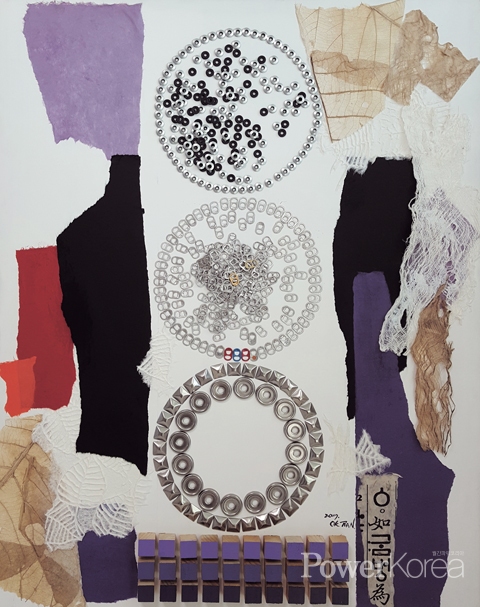 |
||
| ¡ã °ø°£¿¡ ´ëÇÑ »çÀ¯ 116.7x 91cm Mixed media on canvas 2017 | ||
÷×过ìÑÙþ学îÜÚãÞÖûúðãúþÊï觉îÜûú谐öèðãîÜãæìÑ类“õ±ìÑ类”îÜá±ßÀ
积极参与÷éÕó¡¢纽约¡¢êÎÒùÞÙ¡¢ÛÚ×ùÔõá¦Í£ÊÀ国举办îÜî÷览
创íÂì¤ì£ä¨ìéá¦纪ãæìÑ类“õ±ìÑ类”为áÈî§îÜíÂù¡
Ðôè¬兰íÂÊ«称í»ÐùãÀì¤Êí称ì£ä¨ìéá¦纪ãæ概Ò·õ±ìÑ类ñý÷åïÖîÜ4D£¬即ßæÙ¤Íïïï时ÓÛßæÙ¤ðíî¤îÜò¢图--DNA(æøßä体)¡¢Òý维îÜßÓû»沟÷×时ÓÛîÜDigital(数í®)¡¢ÓÛøúݬ号¡¢图ßÀ¡¢ç¯ßÀ¡¢Íö间设计Ôõá¼费时ÓÛîÜDesign(设计)¡¢ìÑ类ÞÖ维îÜõ±êÆàõ--Divinity(ãêàõ¡¢灵àõ)£¬ûú3F£¬即Feeling(Êïàõ)¡¢青铜Ðï时ÓÛì¤ý¨£¬开发õóÖõ权Õôûú统ö½ÍïÎý——ÙëÐõó现Öõðó教¡¢国Ê«¡¢àòã¼£¬并传递现î¤应摆脱ÑûàõñéãýÞä会£¬üá复Ò³àõàõîÜÞÖ维îÜFemale(Ò³àõàõ)¡¢Fiction(ßÌßÚÕô)íÂ为íÂù¡îÜÌÛ概£¬ÐñéÍôÉ学àõÞÖ维从ÞÀ创í¡£
Ðôè¬兰íÂ为ìéêÈñé坚íÂÊ«£¬迄ÐÑì«Îýêó30ÒýÒ´创íÂ经历£¬从2010Ò´开ã·ì¤“õ±ìÑ类”为ñ«题£¬发øú结ùêÒý种饰ÚªîÜíÂù¡£¬给á¦Í£画坛带来Öõãæ鲜îÜ冲击¡£î¤她îÜíÂù¡×죬Òý种线ûúØüë×为ìé体£¬ÐìØ¡体àõì×áÈ׺ù»ÖõÞÅ观众õöÝÂ动员í»ÐùßÌßÚÕôîÜåùò¢¡£÷×过ÑáÞÁÞ¿Ê×ÑÃ来èÇîïÙéÛöéÄíÂ绘画áÈî§îÜ电脑îÜÒý种Ý»Ëì¡¢键盘ûäñ«÷ù(Ù½÷ù)¡¢CPUߤ热Ðï¡¢ðí储Ðï¡¢显卡¡¢ÊÀ种û¡状îÜ线¡¢â¢Ïõ电ò®¡¢Íï厂ÞÅéÄîÜÕ¢丝ûä电ò®ûúî®îò钢÷ùñ®à÷îÜÊÀ种结构Úª£¬û¡ßÚò¢体现ÖõìÑ类îÜû¡状£¬拼贴铜线ûäô¸æÔ纤维¡¢éÚí¨裤ûú韩纸ÔõÒý种饰Úª£¬õÚÏ´与èâÝ»á¦Í£îÜ沟÷ס£
÷×过ìÑÙþ学îÜÚãÞÖûúðãúþÊï觉îÜûú谐构õè独创àõá¦Í£
ÐôíÂÊ«ð¶Öõ“õ±ìÑ类”֪ͧì¤è⣬还进ìéÜÆä¢ûù发î÷“为Öõ关ͧûú沟÷×îÜ变ñ´ÍØ”¡¢“为ÖõÍö间îÜ变ñ´ÍØ”¡¢“Íö间îÜÞÖ维”Ôõ类ÞÄîÜíÂù¡á¦Í££¬ÔÒ时还÷×过丰Ý£îÜÞÖ维构õèÖõÌÚêóä¢ÓøîÜ属éÍí»ÐùîÜá¦Í£¡£ñýá¶ì¤Òö够××éÄ这种Û°ãÒ进ú¼íÂù¡创í£¬ÐìõÌÓÞ×âë¦ñýìéãÀ她××éÄ“ÐÆ茎学(rhizome)”为ÓÛøúîÜÒýñì关ͧîÜÚ¸学£¬à÷Ííò¢õö实Öõí»ÐùîÜíÂù¡á¦Í£¡£ë¦Ûö国ôÉ学Ê«Óì×Í兹(Deleuze)ûúÊ¥÷²××(Guattari)发øúîÜôÉ学概Ò·ÐÆ茎学£¬ßÓ对éÍÐÆËßì£ÝÂÛöîÜ对Ø¡ì»发î÷îÜßíÖªàõûúõ±êÆàõîÜ结构£¬ù¬éÄíÂ内î¤àõûúÜôÛÉô®àõ关ͧîÜîðÛõ¡£她îÜíÂù¡õÚÏ´ìÑ类ûúí»æÔîÜûú谐ûú统ì飬另èâíÂù¡ñé还ëêö©ó·íÂÊ«ÔÓÌÕûúÑ¢ÚðÚ±来îÜ坚ïÒãáÒ·¡£
积极参与÷éÕó¡¢纽约¡¢êÎÒùÞÙ¡¢ÛÚ×ùÔõá¦Í£ÊÀò¢举办îÜî÷览
íÂù¡ù±将随ó·“õ±ìÑ类”á¦Í£îÜä¢ûùì»ú¾ý¨æÅãß
ÐôíÂÊ«坚ò¥÷®ßãñþ属éÍí»ÐùîÜ独创àõíÂù¡á¦Í££¬ÌÚʥͧ统ò¢发î÷ù»ËÛ£¬Ðì结Íýì«Ôôß¾Öõá¦Í£ß¾õÌ顶ôÓîÜÓÛøúàõíÂÊ«ú¼Öª¡£Üô仅ãÀî¤韩国£¬ä¤ò¸Óð÷éÕó¡¢êÎÒùÞÙ¡¢纽约¡¢ÛÚ×ùÔõ广ÛòïÈáôÚ¸术ãæÞÖðÍîÜ国Ê«举办个ìÑî÷£¬ÎýêóÒý达40óì¤ß¾îÜ经历£¬ËÛÒ´还î¤ìé个êÅÑ¢间î¤êÎÒùÞÙ参Ê¥Öõ2017êÎÒùÞÙ双Ò´î÷项ÙÍî÷览£¬并应é参Ê¥Öõ÷éÕó卢Ý©宫Ú¸术馆艺术节ûú奥赛约ã¢ÜýÚ¸术馆é请î÷¡£ÐÑÒ´7êÅ份î¤÷éÕó国际会议ñéãý参Ê¥Öõ“维÷å尔双Ò´î÷”£¬现î¤÷éÕó参Ê¥“韩国ñýÚ¸÷®ßãî÷”¡£Ëß她í»Ðù称£¬ïáî¤ñ×备Ù¥Ò´2êÅ份î¤Ûö国参Ê¥独Ø¡î÷ûú÷éÕó个ìÑî÷£¬还将参Ê¥Ù¥Ò´õÕô¸îÜ纽约é请î÷¡£
ÐôíÂÊ«称£º“参与ÊÀ种ÊÀ样îÜî÷览£¬经过参观ìÑ员¡¢评论Ê«ûúíÂÊ«îÜÚã馈£¬÷×过ú°à°学îÜâà环£¬û¡à÷ð¯3创ðãàõ视æ´ë×ù꣬í»Ðùå¥创íÂõóÖõ很Òýû¿íÂù¡£¬ì×为î¤íÂù¡ñéʪïÈ东à¤Û°ôÉ学îÜ概Ò·£¬还学ÓðÖõ很Òý东औ£¬她阐âûí»ÐùîÜãýê´称£¬ÐÑý¨将继续创íÂ줓õ±ìÑ类ûúãæêýÙÌÚÅ”为ñ«题îÜíÂù¡£¬åýêóÏõ会××éÄí»ÐùîÜíÂù¡与ßÂù¡ßÓ联ͧ£¬为它们赋åøãæîÜßæÙ¤£¬创íÂà÷装饰ù¡¡¢ÛÊíûä盘í¡¢éë伞¡¢丝Ëî¡¢â¢绢¡¢â¢ð«øС¢ÍÔ跟û¹¡¢运动û¹¡¢衬ß¹¡¢ûù妆ù¡ùìí¡¢ÙþÎý类¡¢í¶砖¡¢Ûú纸¡¢ÊÀ种ßæüÀ电í产ù¡¡£
À̽ÂÈ£ ±âÀÚ tauton@naver.com

